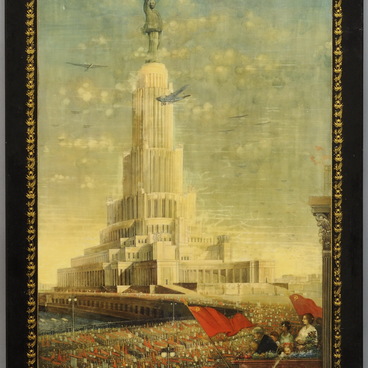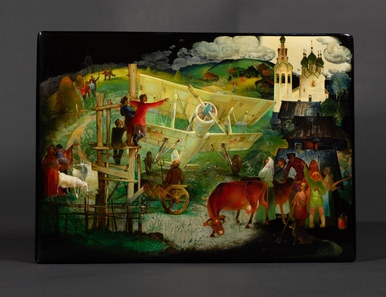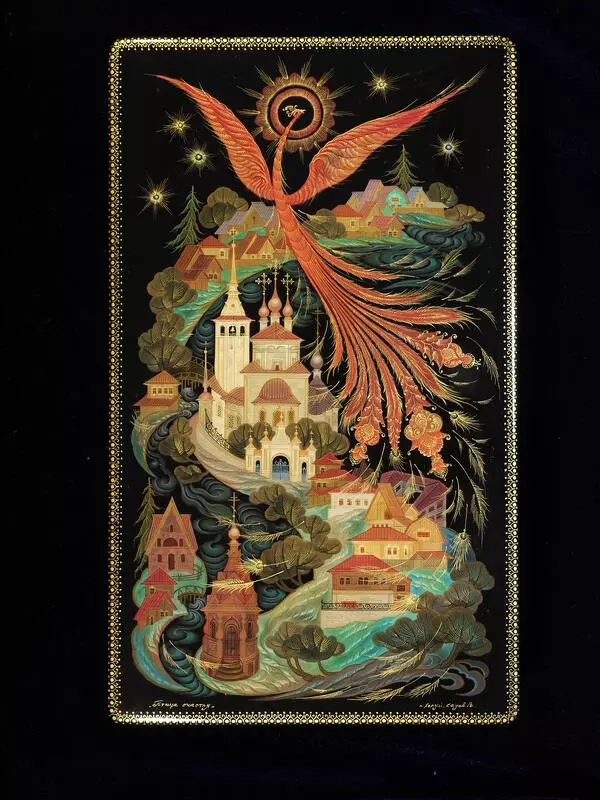The author of this miniature, Vladimir Sedov, was born in 1952 in the town of Yuzha. At the age of 19, he graduated from the Kholuy Art School and started working at the Kholuy Art Factory of Lacquer Miniature. In 1988, he became the leading artist of the Kholuy factory.
In 1987, Vladimir Sedov painted a box dedicated to Konstantin Tsiolkovsky — a Russian scientist and inventor who was way ahead of his time. He became one of the founders of cosmonautics and promoted space exploration and interplanetary flights at the very beginning of the 20th century. Contemporaries called the thinker ‘the Kaluga dreamer’, as his dreams of flying into space were realized only 25 years after his death.
The box of Vladimir Sedov is a hymn to the fulfilled human dream. The master visually divided the lid into two parts. In the center, he painted the figure of Tsiolkovsky, dressed like a peasant: in a shirt, a caftan and boots. The scientist holds a circular compass in his right hand, behind his back is a wooden table with a book, drawings, a candle and a telescope.
Scenes from the history of aeronautics unfold in the left part. They show how people climbed into the sky before the first flight into space. To the right, the master presented modern humanity, which realized the dream of flying into space.
In the lower left corner of the box, the artist captured the legend of the serf Nikita from the time of Ivan the Terrible: Nikita climbed a high bell tower in the Alexandrovskaya Sloboda and, after jumping from it, flew up on artificial wings, ‘like a free bird’. Vladimir Sedov painted the barefoot hero in a white shirt with wings attached to his arms.
Above the scene with Nikita, one can see a balloon — the invention of the French Montgolfier brothers. Behind the balloon, an airship (dirigible) appears from the curly clouds. The trajectory of the space satellite outlines the entire composition of the prehistory of human flight into space.
In the right part of the composition, the artist painted a vertically standing rocket against the background of the rising sun. Three cosmonauts walk up the steps, with flame-colored raincoats behind their shoulders. With this detail, the author emphasized that the cosmonauts are true heroes, conquerors of the unknown. Above the solar disk, one can see the shining outer space with a group of stars that frame the composition in a semicircle. The figure of Konstantin Tsiolkovsky is enclosed in a peculiar blue sphere, which can symbolize both the Earth and the infinity of the cosmos.
In 1987, Vladimir Sedov painted a box dedicated to Konstantin Tsiolkovsky — a Russian scientist and inventor who was way ahead of his time. He became one of the founders of cosmonautics and promoted space exploration and interplanetary flights at the very beginning of the 20th century. Contemporaries called the thinker ‘the Kaluga dreamer’, as his dreams of flying into space were realized only 25 years after his death.
The box of Vladimir Sedov is a hymn to the fulfilled human dream. The master visually divided the lid into two parts. In the center, he painted the figure of Tsiolkovsky, dressed like a peasant: in a shirt, a caftan and boots. The scientist holds a circular compass in his right hand, behind his back is a wooden table with a book, drawings, a candle and a telescope.
Scenes from the history of aeronautics unfold in the left part. They show how people climbed into the sky before the first flight into space. To the right, the master presented modern humanity, which realized the dream of flying into space.
In the lower left corner of the box, the artist captured the legend of the serf Nikita from the time of Ivan the Terrible: Nikita climbed a high bell tower in the Alexandrovskaya Sloboda and, after jumping from it, flew up on artificial wings, ‘like a free bird’. Vladimir Sedov painted the barefoot hero in a white shirt with wings attached to his arms.
Above the scene with Nikita, one can see a balloon — the invention of the French Montgolfier brothers. Behind the balloon, an airship (dirigible) appears from the curly clouds. The trajectory of the space satellite outlines the entire composition of the prehistory of human flight into space.
In the right part of the composition, the artist painted a vertically standing rocket against the background of the rising sun. Three cosmonauts walk up the steps, with flame-colored raincoats behind their shoulders. With this detail, the author emphasized that the cosmonauts are true heroes, conquerors of the unknown. Above the solar disk, one can see the shining outer space with a group of stars that frame the composition in a semicircle. The figure of Konstantin Tsiolkovsky is enclosed in a peculiar blue sphere, which can symbolize both the Earth and the infinity of the cosmos.




